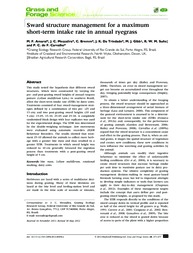Sward structure management for a maximum short-term intake rate in annual ryegrass.
Sward structure management for a maximum short-term intake rate in annual ryegrass.
Author(s): AMARAL, M. F.; MEZZALIRA, J. C.; BREMM, C.; TRINDADE, J. K.; GIBB, M. J.; SUÑÉ, R. W.; CARVALHO, P. C. de F.
Summary: This study tested the hypothesis that different sward structures, which were constructed by varying the pre- and post-grazing sward heights of annual ryegrass pasture (Lolium multiflorum Lam.) in southern Brazil, affect the short-term intake rate (STIR) by dairy cows. Treatments consisted of four sward-management strategies defined by a combination of two pre- (25 and 15 cm) and two post-grazing sward heights (10 and 5 cm): 15-05, 15-10, 25-05 and 25-10. A completely randomized block design with four replicates was used for the experimental design. The STIR was determined by the double-weighing technique. Jaw movements were evaluated using automatic recorders (IGER Behaviour Recorder). The results showed that treatment 25-10 allowed the animals to collect more herbage with a greater bite mass and thus resulted in a greater STIR. Treatments in which sward height was reduced to 10 cm generally favoured the ingestion process than treatments with a post-grazing sward height of 5 cm.
Publication year: 2013
Types of publication: Journal article
Keywords: Azevém, Vaca leiteira
Observation
Some of Embrapa's publications are published as ePub files. To read them, use or download one of the following free software options to your computer or mobile device. Android: Google Play Books; IOS: iBooks; Windows and Linux: Calibre.
Access other publications
Access the Agricultural Research Database (BDPA) to consult Embrapa's full library collection and records.
Visit Embrapa Bookstore to purchase books and other publications sold by Embrapa.

